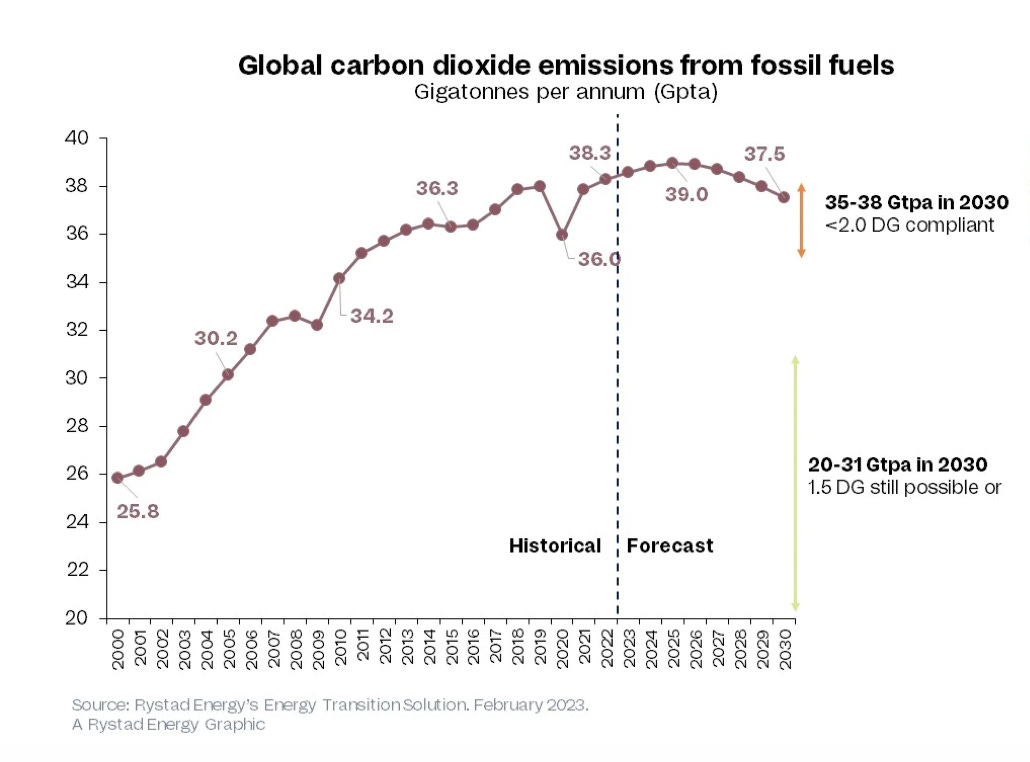And why there's more than nothing we can do about it.
 , TONY POVILITIS, AUG 8, 2023
, TONY POVILITIS, AUG 8, 2023
Historically, worldwide CO2 emissions have gone up each and every year unless there's a major crisis that puts a dent in global economic growth. So emissions dipped temporarily in the early 1990s after the collapse of the Soviet Union, and they fell temporarily in 2008 with the financial crisis. But once growth returns, they usually go up, up, up. — Brad Plumer, climate reporter, Vox 2015).

Sure enough, carbon emissions continue upward. Our civilization is built on fossil fuels. We can't quickly erase that history.
Fossil fuels—including coal, oil, and natural gas—have been powering economies for over 150 years, and currently supply about 80 percent of the world's energy. — Environmental and Energy Study Institute, 2021.
Rising global carbon dioxide emissions since 1900.
Note the recent dip in global CO2 emissions in the graph. That reflects an impressive drop of 5.8% for the year 2020. Not by coincidence, the world economy shrunk by nearly 3.5% due to the covid pandemic. But virtually no one got the broader message—cool down the economy to immediately cut carbon emissions!
The following year, global civilization was back on track overloading the atmosphere with carbon dioxide. The economy “bounced back” as world gross domestic product (GDP) and carbon emissions rose by 9% and 6% respectively.
According to the International Energy Agency, in 2022 global carbon dioxide (CO2) emissions from energy combustion and industrial processes grew…to a new all-time high of 36.8 Gt. In a year marked by energy price shocks, rising inflation, and disruptions to traditional fuel trade flows, global growth in emissions was lower than feared, despite gas-to-coal switching in many countries. Increased deployment of clean energy technologies such as renewables, electric vehicles, and heat pumps helped prevent an additional 550 Mt in CO2 emissions. Industrial production curtailment, particularly in China and Europe, also averted additional emissions.
Global carbon emissions decline with drops in economic growth as seen, for example, in 1980-83, 2009, and 2020.
The most hopeful analysts forecast that carbon emissions will peak in 2025 “as global decarbonization picks up steam“ and then gradually decline, as seen in the next graph.
Under this scenario, carbon emissions will continue to rise until about 2025 then begin to drop to avoid what could be a catastrophic 2 degree C (DG) rise in global temperature above pre-industrial levels. According to scientific consensus, anything beyond that would dramatically alter life on Earth as we know it. A 1.5 degree limit is considered far preferable but seems now beyond reach. The Earth is currently about 1.1°C warmer than it was in the late 1800s (In the graph, Gtpa stands for gigatonnes of carbon dioxide per annum.)
So, how likely is it that global decarbonization will “pick up stream” to limit global heating to under 1.5 or 2 degrees C of preindustrial levels?
Not very! According to the UN’s Emissions Gap Report 2022, the international community is falling far short of the Paris goals, with no credible pathway to 1.5°C in place. Only an urgent system-wide transformation can avoid climate disaster…Policies currently in place with no additional action are projected to result in global warming of 2.8°C over the twenty-first century. Implementation of unconditional and conditional NDC scenarios reduce this to 2.6°C and 2.4°C respectively. (An “NDC” is a country’s ambition or target for reducing emissions).
The UN and world leaders are betting the house on a surge in “sustainable development” powered up by massive development of solar, wind, geothermal, hydro, and nuclear energy. They are betting on the emergence of new, cost-efficient technologies for capturing and storing atmospheric carbon dioxide.
But those same leaders dare not mention the option of cooling down the world’s economy to quickly reduce CO2 and other greenhouse gas emissions.
How can anyone honestly think that we can rescue the climate through “system-wide transformation” without scaling down economic growth, specifically in overconsuming countries? Is this delusional or a cruel hoax?
The UN’s latest climate report presents a utopian wish list to change the world. In short order, civilization is supposed to switch to “clean” energy, reduce destruction of nature and restore it, improve agriculture, water use and waste management systems, build more efficiently, switch to electric vehicles, improve governance and cooperation, increase “green” financing, improve social safety nets, and promote equity and inclusion. Who could argue with this fantasy? The world’s politicians nod and applaud.
To keep warming within 2℃ above pre-industrial levels, global greenhouse gas emissions must decline by around 21% by 2030 and around 35% by 2035. Keeping warming below 1.5℃ requires even stronger emissions reduction. This is a very tall order in light of emissions trajectories to date. — PBS March 2023
At everyone’s peril, world leadership now promises a theoretical "decoupling" of economic growth from environmental harms, a feat never accomplished by industrial civilization.
Not everyone is impressed:
The conclusion is both overwhelmingly clear and sobering: not only is there no empirical evidence supporting the existence of a decoupling of economic growth from environmental pressures on anywhere near the scale needed to deal with environmental breakdown, but also, and perhaps more importantly, such decoupling appears unlikely to happen in the future. — Decoupling Debunked. — A report by the European Environmental Bureau.
I’m always reluctant to talk mainly about climate change. Sure it’s a big deal, and it’s dangerous, but environmental deterioration is obviously about a lot more than climate change. It is fundamentally about wholesale destruction of life and the natural systems that support it. It’s about a growth-crazed, narcissistic civilization that has lost touch with reality.
Fortunately, there is a small but strengthening "degrowth" movement that’s trying to enlighten society about the need to draw down economic activity, if not human numbers. Unfortunately, it gets little attention despite constant screaming in the corporate media about the “existential threat” of climate change.
Besides holding our ears, what can we do? The truth is that we can’t do much to slow global GDP. But we can take great pride in limiting our family’s consumption of energy and less-than-needed products, and protecting wildlife and nature at every opportunity. In short, adopting a personal practice of sufficiency rather than acquisition.
For many of us it’s not easy to speak out publicly on the matter of economic overgrowth, particularly when you are likely to be labeled “fringe.” But we must.
My dear friends, keep your spirits up. As Henry Thoreau assures us, "Only that day dawns to which we are awake." It’s enormously gratifying to share your good company.
Yesterday at sunrise, I marveled at trees, their glimmering leaves and sunbeams. What a wonderful, precious world. I’m told there’s no time to waste on despair.

Photos: T. Povilitis.
Article source: scaledown.substack.com


